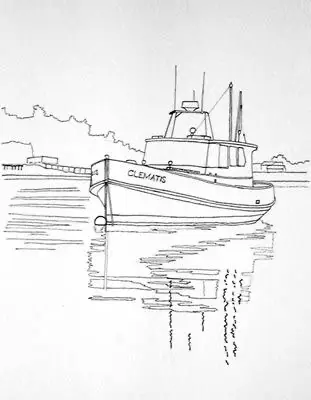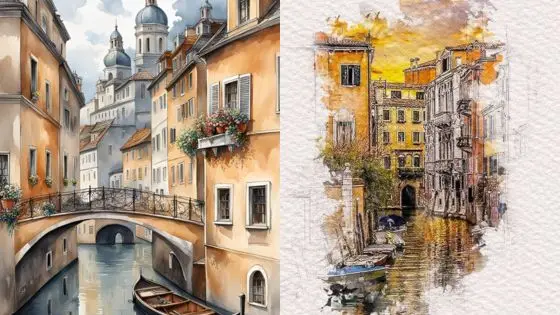Drawing boats can be a fun and rewarding way for anyone to express their creativity. Whether it’s a simple sketch or a detailed illustration, boat drawing combines art with a sense of adventure. Many artists find inspiration in the lines of boats and the reflection of water, making it a unique subject for artwork.


When starting with boat drawing, understanding basic shapes can make a difference. The process can be as straightforward as sketching a few lines to capture the shape of a sailboat or yacht. Using different techniques, artists can create images that evoke feelings of freedom and exploration.
This blog post will explore various styles of boat drawing, offer tips for beginners, and highlight how anyone can enjoy this aspect of arts and crafts. Readers will discover that drawing boats isn’t just about technique; it’s also about finding personal inspiration and joy in the art.
The Basics of Boat Drawing


Boat drawing involves understanding the structure and design of boats. This knowledge helps in creating accurate and appealing drawings. Key elements include boat anatomy, material selection, and organizing a drawing space.
Understanding Boat Anatomy
Boat anatomy consists of different parts that contribute to its design. Key components include the bow, stern, and water line.
- Bow: The front part of the boat, often designed to cut through water.
- Stern: The back end of the boat, important for steering and stability.
- Water Line: This line marks where the boat floats on the water. It is crucial for understanding how the boat sits in its environment.
Familiarity with these parts helps in creating realistic drawings. Knowledge of the boat’s architecture promotes better design and proportions.
Choosing the Right Materials
Choosing the right materials influences the quality of boat drawings. Common materials include:
- Pencil: Great for detailed sketches and easy edits.
- Canvas: Ideal for painting or creating textured effects.
- High Gloss Photopaper: Suitable for printing finished designs, enhancing color vibrancy.
Selecting appropriate paper or canvas affects texture and presentation. Using quality materials improves durability and appearance of the artwork.
Setting Up Your Drawing Space
Creating an organized drawing space is vital. It enhances focus and creativity. Consider the following tips:
- Lighting: Ensure there is good lighting to avoid eye strain.
- Clean Surface: A clean table helps in spreading materials and prevents clutter.
- Tools Within Reach: Keep pencils, paints, and paper accessible to increase efficiency.
Having everything organized simplifies the drawing process. A comfortable environment encourages more enjoyable and productive drawing sessions.
Drawing Techniques and Tips


Drawing a boat requires specific techniques to capture its shape and details. Using effective methods can enhance the overall appearance of the artwork. Here are some essential techniques to consider.
Sketching the Outline
Begin with a light pencil to sketch the basic shape of the boat. Focus on key elements like the hull, sail, and any additional features.
- Use geometric shapes to guide the drawing.
- For sailboats, draw a triangle for the sail and a rounded shape for the hull.
Keeping proportions in mind is important. Step back and look at your sketch often. Adjusting details early saves time later.
Shading and Texture


Shading adds depth and realism to the boat. It gives shape and dimension to the flat sketch.
- Use hatching and cross-hatching techniques to create shadows.
- Darker areas usually happen on one side of the boat or beneath the deck.
Consider the light source when shading. This helps create consistent highlights and shadows. For a wooden boat, add texture by creating lines and curves on the surface.
Creating Depth and Dimension
To make the drawing more lifelike, add elements that suggest depth. Layering objects helps accomplish this.
- Draw distant boats smaller than those in the foreground.
- Use lighter shades for distant objects and darker shades for closer ones.
Incorporating metallic mirrors in the water can enhance realism. Reflective surfaces create a dynamic composition. Ensure the reflections match the boat’s colors and shapes for consistency.
Subjects and Themes in Boat Art


Boat art often showcases diverse subjects and themes that reflect history, nature, and wildlife. Artists capture traditional vessels, integrate landscapes, and represent the beauty of flora and fauna. Each theme brings a unique perspective to boat drawings.
Historical and Traditional Boats
Many boat drawings feature historical and traditional vessels. These artworks often depict classic designs like fishing boats, sailboats, and gondolas. Artists focus on the shapes, colors, and materials used in these boats.
These images can tell stories about maritime cultures and their practices. They might show boats used for trade, transportation, or fishing. Artists include details like sails or nets to enhance the scene’s authenticity.
Additionally, many artworks celebrate the craftsmanship behind these vessels. This includes wooden boats with intricate carvings. Highlighting these elements honors the skills of boat builders throughout history.
Landscape and Seascape Integration
Boat art frequently integrates landscapes and seascapes. This combination creates a richer visual experience. Artists place boats against vibrant skies, calm waters, or rocky shores.
Landscapes can range from peaceful lakes to dramatic oceans. This setting enhances the mood of the artwork. Artists might use various techniques to capture reflections and light, making the water appear alive.
By showing boats in different environments, artists convey stories of adventures and journeys. Each backdrop adds context to the boat’s purpose, whether fishing along a serene shore or sailing through stormy seas.
Incorporating Wildlife and Natural Elements
Wildlife is another important theme in boat art. Artists often include animals like birds, fish, or marine life alongside boats. This adds life and movement to the artwork.
For example, a boat drawing might show fishermen casting nets as seagulls circle above. These details connect boats to their environment, highlighting their role in nature.
Flora is also essential in many pieces. Artists may depict lush greenery or coastal plants surrounding boats. This inclusion not only beautifies the scene but also emphasizes the connection between boats and their natural settings.
Cultural and Regional Variations


Boat drawing has different styles and meanings across cultures and regions. Each area reflects unique traditions, materials, and historical influences in its boat art.
World Maritime Traditions
Many cultures have rich maritime traditions that influence their boat drawings. For example, European art often shows wooden sailing ships. Countries like Norway and Greece have distinct styles. In Africa, colorful boats and strong patterns represent local fishing practices. Artists create pieces that highlight the importance of the sea to their history and daily life.
American Nautical Art
In the United States, boat drawings reflect coastal geography and culture. New England states, like Maine, celebrate fishing and maritime life in their art. Texas has its own themes, often showing shrimp boats and large vessels. Americana influences also appear in artwork, showcasing classic sailboats and historic ships. Artists use details like colors and shapes to represent the spirit of American maritime activities.
Asian Maritime Paintings
Asian countries bring unique expressions to boat art. Japan often features serene landscapes with wooden boats on calm waters. Chinese art can show fishing boats with vibrant colors. Southeast Asia reflects local cultures with intricate boat designs. Both history and geography shape these maritime paintings, telling stories of trade, fishing, and travel across waterways.
Contemporary Approaches to Boat Drawing


Boat drawing today blends various styles and techniques. Artists experiment with new ideas while respecting traditional forms. The following sections showcase distinct methods artists use to represent boats.
Abstract and Modernist Interpretations
Modern artists often take a fresh look at boats through abstraction. They focus on shapes, colors, and lines rather than realistic details. For example, Richard Sherman’s photography captures boats in a unique light. He plays with angles and shadows, making simple vessels look extraordinary.
Artists like Kate Mancini create colorful, pop art versions of boats. Her vibrant designs appeal to a younger audience. They include bold colors and playful forms, showing boats as fun and lively. These modernist interpretations challenge viewers to see beyond the conventional and appreciate art in new ways.
Conceptual Boat Artwork
Conceptual boat artwork emphasizes ideas over traditional representation. Artists use boats as symbols to convey deeper messages. Nancy Sharpe, for instance, might explore themes of journey and adventure through her work. She makes viewers think about the meaning behind what they see.
Triptychs are popular for conceptual artwork, allowing artists to tell a story in three parts. Each panel can represent a different aspect of the same theme. This approach invites viewers to engage with the artwork on multiple levels. It encourages them to reflect on their own experiences with boats and travel.
Fusion of Traditional and Contemporary Styles
Some artists blend traditional techniques with contemporary ideas. Martha Spak Fine Art is known for combining classic boat drawings with modern twists. This fusion creates a unique visual experience. Artists can give fresh life to age-old methods while keeping their essence intact.
The use of traditional materials, like watercolors or charcoal, alongside modern designs shows versatility. This mix allows artists to cater to diverse tastes. It helps connect older art forms with current trends, making boat drawings relevant today. Creative expressions continue to push boundaries, exciting art lovers everywhere.
Displaying and Sharing Boat Drawings


Boat drawings can be beautifully showcased in various ways. Framing options, sharing online, and incorporating them into home decor can enhance their appeal. Here are some effective methods to display and share these art pieces.
Framing and Presentation
Choosing the right frame is crucial for any artwork, including boat drawings. A simple frame can make a drawing stand out, while a more ornate style adds elegance.
Common framing materials include wood and metal. Some may opt for high gloss photopaper for a modern touch. The choice of matting also matters; a neutral color highlights the drawing without overwhelming it.
Art exhibitions provide great opportunities to display work. A gallery setting allows for organized viewing, often enhancing the experience for visitors. Proper lighting can also amplify details in the boat drawings.
Online Platforms and Social Media
The internet offers numerous platforms to share boat drawings. Websites like Instagram and Pinterest allow artists to showcase their work to a broad audience. Both platforms prioritize visual content, making them ideal for sharing art.
Creating an online gallery can also attract more views. Many artists use dedicated sites to present their collections. Sharing stories behind each drawing can engage viewers and invite discussions.
Joining online art communities can be beneficial. These platforms often foster support among artists and provide feedback, which is valuable for growth.
Boat Art in Interior Design
Boat drawings can add charm to home decor. Placing a drawing in a living room can create a coastal vibe.
Incorporating these pieces into the Greenbrier Lifestyle Collection enhances thematic elements. Displaying art within metallic mirrors or on accent walls can create stunning focal points.
Using boat drawings in unexpected places, like a bathroom or hallway, can surprise guests. Thoughtful placement not only beautifies spaces but also reflects personal style and passions.
The Commercial Aspect of Boat Drawing


Boat drawing has a vibrant commercial aspect that includes various selling methods and art forms. Artists explore art markets, offer prints, and accept commissions, creating many opportunities to share their work.
Navigating Art Markets
Boat drawings can be found in diverse art markets. Artists may join galleries that focus on marine art or participate in local art fairs. Through catalogs and lookbooks, they can showcase new releases and best sellers. Vintage boat art also attracts buyers looking for unique pieces.
Online platforms provide a space for artists to reach wider audiences. Social media can help artists connect with potential customers. Clear images and engaging descriptions are vital for attracting buyers. Price points can vary from affordable prints to higher-priced originals, catering to different budgets.
Prints and Reproductions


Prints and reproductions of boat drawings are popular among collectors. Artists can color match their prints to ensure they reflect the original artwork accurately. Selling prints allows for wider distribution without compromising the artwork’s integrity.
Artisans can offer various styles, from whimsical to realistic, appealing to different tastes. Limited editions can create a sense of exclusivity. With proper marketing, artists can promote their prints effectively, driving sales and growing their brand.
Commissioned Boat Art
Commissioned boat art allows clients to request custom pieces. This process can be rewarding for both the artist and the buyer. Artists work directly with clients to understand their vision, ensuring satisfaction.
Prices for commissioned work can vary based on size and detail. Clients seek personalized touches, often wanting specific boats or scenes depicted. Clear communication and detailed contracts help manage expectations. Ultimately, commissioned pieces can deepen connections between artists and their clients, adding emotional value to the artwork.
- 2.4Kshares
- Facebook0
- Pinterest2.4K
- Twitter3
- Reddit0



